Click on a picture to enlarge it
| Snakes in Movies Group Pages |
All Movie Snakes Must Die! |
| All Movie Snakes Want to Kill You! |
| Dancing With Snakes |
| Giant Monster Snakes |
| Pet Snakes |
| Shooting Snakes |
| Snake Bites |
| Snake Charmers |
| Snake Face |
| Snake Fights |
| Snake People |
| Snake Pits |
| SnakeSexploitation |
| Snakes & Skulls |
| Snakes Run Amok |
| Snakes Used as Weapons |
| Snakes Used for Comedy |
| Snakes Used for Food or Medicine |
| Snakes Used Realistically |
| Throwing and Whipping Snakes |
| Kinds of Snakes |
| Rattlesnakes |
| Cobras |
| Black Mambas |
| Boas, Pythons, and Anacondas |
| Kingsnakes and Tricolor Snakes |
| Unusual Species
|
| Settings |
| Snake in the House! |
| Snakes in Beds |
| Snakes in
Jungles and Swamps |
| Snakes In Trees |
| Genres & Locations |
| Snakes In Westerns |
| Snakes in Asian Movies |
| Herps in Australian Movies |
| Herps in James Bond Movies |
| Herps in Silent Movies |
| Herps in Spielberg Movies |
| Snakes in Movies | ||
| Snake Woman's Curse Kaidan hebi-onna (1968) | ||
| Spoiler Alert ! Some of these pictures and descriptions may give away plot details that you might not want to know before watching the film. |
||
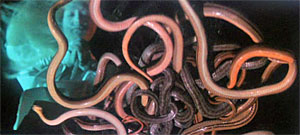 |
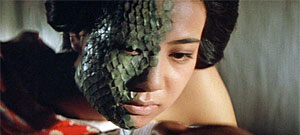 |
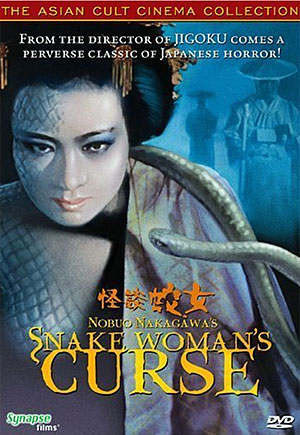 |
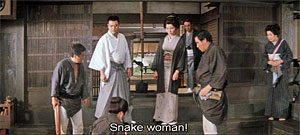 |
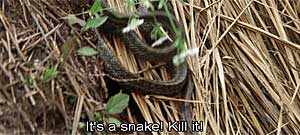 |
|
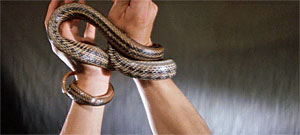 |
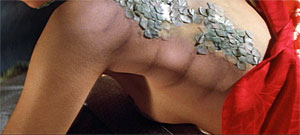 |
|
 |
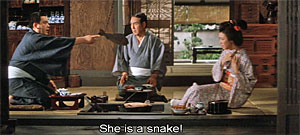 |
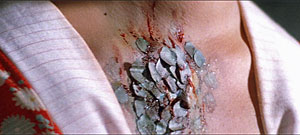 |
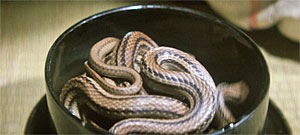 |
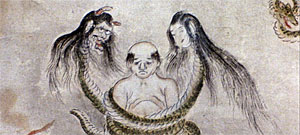 |
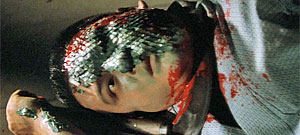 |
| I need to completely spoil this movie in order to talk about it so beware. This is a hauntingly beautiful Japanese ghost story that takes place in the early days of the Meiji Period (1868-1912) in the non-westernized village of Onuma in the remote countryside of northern Japan. In the isolated region where tall cliffs prohibit a fishing industry villagers can only survive by farming. The Onuma family owns all the land and treat the tenant farmers without sympathy or fairness. A poor tenant farmer, Yasuke, his wife Sue, his daughter Asa, and her boyfriend Sutematsu are all killed, driven to death or driven to suicide by the unscrupulous landlord Chobei Onuma, his cruel and jealous wife, and their son Takeo who abuses and rapes the women who work in his father's weaving factory. After Sue and Asa are forced from their farm to work in the Onuma house as little more than slaves, a snake is found inside the house and several men rush to beat it to death. Sue cries out for them to stop because she feels sorry for it. They call her a Snake Woman and Mr. Onuma rushes in to throw her against a pile of firewood, splitting open her head, an injury which eventually kills her. Because she is killed for trying to protect a snake, I assume that this is how and why she becomes the snake woman of the title, although she never turns completely into a snake, she just has patches of snake scales on her body. This film is all about socioeconomic injustice - the abuse of the poor by the rich in an outdated feudal system. The poor's revenge here is the curse of the snake woman - the terrifying guilt that the wrong-doers feel which eventually destroys them. This guilt manifests itself in the appearance of snakes and visions of snakes and visions of people turning into snakes: such as when the son Takeo, who rapes Asa shaming her into suicide, sees a vision of his brand new wife Kinu turning into a snake, which isn't really happening; when Mrs. Onuma sees a vision of a snake in her rice bowl, which isn't really there; and when Mr. Onuma sees the ghosts of the people whose lives were lost because of him and then is terrified by snakes which seem to be real ones, including a snake everyone sees in a temple during some kind of exorcism ritual, which terrifies Mr. Onuma into demanding that the people burn the forests to kill all the snakes. Innocent people see the ghosts of their loved ones, but they are not terrifying visions and they are not accompanied by visions of snakes. All of these appearances of harmless snakes in the film (many of which were thrown into a scene by someone outside the frame of the camera) were no doubt meant to scare the audience, and probably still do today, but none of the snakes bites or attacks anybody. There is one scene where we see a snake wrapped around Tetsuo's hands as if to tie them up, but it turns out it's only a bad dream and he has a scarf wrapped around his hands. In one scene, we see Asa looking at a painting at an altar that shows visions of what must be Hell. The camera slowly shows us close-ups of people getting chopped up by devils, people swimming in a sea of flames, and two snakes with human heads, one the head of a woman, wrapped around the body of a man, showing that snake women torment the wicked even in Hell. It's the poor farmers who died who we see ascending to Heaven at the end. You can watch the trailer on Youtube |
||